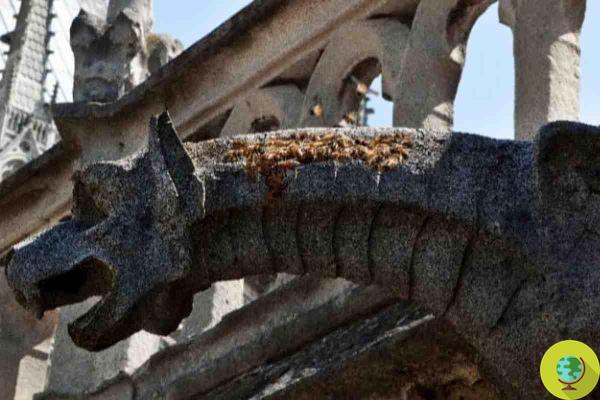
The three bee colonies that survived the Notre Dame fire are in excellent health and will remain on the roof of the cathedral
He is about to end up run over, his mother saves himTen months after the devastating fire of Notre Dame, three o'clock bee colonies living on the roof of the cathedral They are fine, thrive and are ready to produce honey again this year.
The beekeeper who takes care of these urban hives, Sibyle Moulin, was able to visit the bees, seeing for himself the good health of the 30-45 thousand pollinators.
In April of last year, the three colonies of honey bees residing on the roof of Notre Dame since 2013 miraculously survived the flames.
At the time there was much fear for the thousands of bees of Notre Dame which, although not directly reached by the flames, had to deal with temperatures of about 800 ° C and toxic fumes.
In the days following the terrible fire, drone images showed that the hives were intact and in their place and that the bees were fortunately alive.
The insects did not in fact abandon the queen, but gorged themselves with honey and stayed together for protect their colonies.
“We looked at the satellite images and saw that the hives were intact and had not been knocked over and there were no puddles of wax under them. The wax melts around 70 ° C, but they weren't affected by the heat.
We weren't worried about the smoke, because we use it to sedate them, so we knew they would just go to sleep around the queen, ”recalls Moulin.
“Then they sent us some films of some people who worked to protect the cathedral and we could see the bees going in and out of the hives. We studied their behavior and saw that they were carrying pollen balls on their feet, which meant they were stockpiling protein to feed the young. The fact that there were some little bees meant that the queens were fine, ”continues Moulin.
Although this was excellent news, it was not possible to be sure of the good health of the colonies without visiting them in person.
But as the facility has been severely damaged and still unstable and the risk of lead exposure is high, access to the site is limited.
Moulin had to take a health and safety course to be able to resume visits to his bees and, when he reviewed them last July, he was able to personally verify that the pollinators are doing great.
Last summer Moulin, which treats 350 of the approximately 700 beehives scattered over the roofs of the city, collected 66 kg of honey from those of Notre Dame, which were analyzed excluding contamination from lead.
The bees, which were initially thought to be removed from the roof, will instead remain in Notre Dame and will produce their honey again this year.
Read also:
- The 200 bees of Notre-Dame survived the fire!
- Notre-Dame fire: presented the green project to transform the roof into a large greenhouse
- Notre-Dame, there is fear of lead poisoning of children. New tests carried out
- Bees pollinate more flowers in cities than in the countryside, but that's not good news - here's why


























